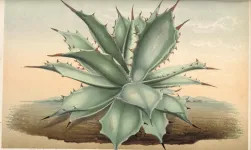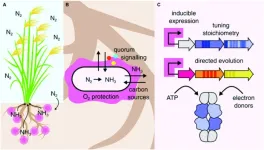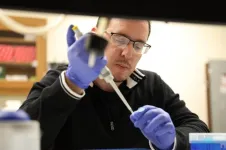(Press-News.org) BOSTON – Mass General researchers have discovered a novel molecular mechanism responsible for the most common forms of acquired hydrocephalus, potentially opening the door to the first-ever nonsurgical treatment for a life-threatening disease that affects about a million Americans. As reported in the journal Cell, the team uncovered in animal models the pathway through which infection or bleeding in the brain triggers a massive neuroinflammatory response that results in increased production of cerebrospinal fluid (CSF) by tissue known as the choroid plexus, leading to swelling of the brain ventricles.
“Finding a nonsurgical treatment for hydrocephalus, given the fact neurosurgery is fraught with tremendous morbidity and complications, has been the holy grail for our field,” says Kristopher Kahle, MD, PhD, a pediatric neurosurgeon at MGH and senior author of the study. “We’ve identified through a genome-wide analytical approach the mechanism that underlies the swelling of the ventricles which occurs after a brain bleed or brain infection in acquired hydrocephalus. We’re hopeful these findings will pave the way for approval of an anti-inflammatory drug to treat hydrocephalus, which could be a game-changer for populations in the U.S. and around the world that don’t have access to surgery.”
Acquired hydrocephalus occurs in about one of every 500 births globally. It is the most common cause of brain surgery in children, though it can affect people at any age. In underdeveloped parts of the world where bacterial infection is the most prevalent form of the disease, hydrocephalus is often deadly for children due to the lack of surgical intervention. Indeed, the only known treatment for acquired hydrocephalus is brain surgery, which involves implantation of a catheter-like shunt to drain fluid from the brain. But about half of all shunts in pediatric patients fail within two years of placement, according to the Hydrocephalus Association, requiring repeat neurosurgical operations and a lifetime of brain surgeries.
By deciphering the unique cellular and molecular biology that occurs within the brain after infection or severe hemorrhage, the MGH-led research team has taken a major step toward nonsurgical, pharmacologic treatment for humans. Pivotal to the process is the choroid plexus, the brain structure that routinely pumps cerebrospinal fluid into the four ventricles of the brain to keep the organ buoyant and injury-free within the skull. An infection or brain bleed, however, can create a dangerous neuroinflammatory response where the choroid plexus floods the ventricles with cerebral spinal fluid and immune cells from the periphery of the brain – a so-called “cytokine storm,” or immune system overreaction, so often seen in COVID-19 infections--swelling the brain ventricles.
“Scientists in the past thought that entirely different mechanisms were involved in hydrocephalus from infection and from hemorrhage in the brain,” explains co-author Bob Carter, MD, PhD, chair of the Department of Neurosurgery at MGH. “Dr. Kahle’s lab found that the same pathway was involved in both types and that it can be targeted with immunomodulators like rapamycin, a drug that’s been approved by the U.S. Food and Drug Administration for transplant patients who need to suppress their immune system to prevent organ rejection.”
MGH researchers are continuing to explore how rapamycin and other repurposed drugs which quell the inflammation seen in acquired hydrocephalus could be turned into an effective drug treatment for patients. “What has me most excited is that this noninvasive therapy could provide a way to help young patients who don’t have access to neurosurgeons or shunts,” emphasizes Kahle. “No longer would a diagnosis of hydrocephalus be fatal for these children.”
Kahle is director of Pediatric Neurosurgery at MGH, and director of the Harvard Center for Hydrocephalus and Neurodevelopmental Disorders. Carter is chief of Neurosurgery Service at MGH and professor of Surgery at Harvard Medical School.
The study was funded by the National Institutes of Health and the Hydrocephalus Association.
About the Massachusetts General Hospital
Massachusetts General Hospital, founded in 1811, is the original and largest teaching hospital of Harvard Medical School. The Mass General Research Institute conducts the largest hospital-based research program in the nation, with annual research operations of more than $1 billion and comprises more than 9,500 researchers working across more than 30 institutes, centers and departments. In August 2021, Mass General was named #5 in the U.S. News & World Report list of "America’s Best Hospitals." MGH is a founding member of the Mass General Brigham healthcare system.
END
New Insights by Mass General on the molecular mechanism of hydrocephalus could lead to the first-ever non-surgical treatment
A noninvasive way to avoid the repeat failures of shunt placement in patients with hydrocephalus has been the holy grail of scientists in the field
2023-03-08
ELSE PRESS RELEASES FROM THIS DATE:
Analyzing child firearm assault injuries by race, ethnicity during pandemic
2023-03-08
About The Study: Child firearm assaults increased substantially during the COVID-19 pandemic in four major U.S. cities, according to the results of this study. Racial and ethnic disparities increased, as Hispanic, Asian, and especially Black children experienced disproportionate shares of the increased violence.
Authors: Jonathan Jay, Dr.P.H., J.D., of the Boston University School of Public Health in Boston, is the corresponding author.
To access the embargoed study: Visit our For The Media website at this link https://media.jamanetwork.com/
(doi:10.1001/jamanetworkopen.2023.3125)
Editor’s ...
eDNA holds the key to safeguarding pollinators amid global declines: Study
2023-03-08
Curtin researchers have uncovered new evidence of western pygmy possums interacting with native flowers, providing the first eDNA study to simultaneously detect mammal, insect and bird DNA on flowers.
The new research, published today in Environmental DNA, examined DNA traces left by animal pollinators on native flora and detected both insect and animal pollinators from multiple flowering plant species at once - a game changer in the face of declining animal pollinators globally.
In North America, some pollinator species have fallen by more than 95 per cent while ...
SIAM Conference on Computational Geometric Design (GD23)
2023-03-08
The 2023 SIAM Conference on Computational Geometric Design, organized by the SIAM Activity Group on Geometric Design, is part of the International Geometry Summit bringing together the Symposium on Physical and Solid Modeling 2023, Shape Modeling International 2023, EG Symposium on Geometry Processing 2023, and Geometric Modeling and Processing 2023.
The 2023 SIAM Conference on Computational Geometric Design seeks high quality, original research contributions that strive to advance all aspects ...
Study associates long COVID with physical inactivity
2023-03-08
The link between symptoms of COVID-19 and physical inactivity is increasingly evident. An article recently published in the journal Scientific Reports by researchers at the University of São Paulo (USP) in Brazil describes a study in which COVID-19 survivors with at least one persistent symptom of the disease were 57% more likely to be sedentary, and the presence of five or more post-acute sequelae of infection by SARS-CoV-2 increased the odds of physical inactivity by 138%.
“Although this was a cross-sectional study, the findings underscore the importance of discussing and encouraging physical activity at all times, including during the pandemic,” ...
Scientists uncover the unexpected identity of mezcal worms
2023-03-08
Mezcal is a distilled alcohol made from the boiled and fermented sap of agave plants. Most mezcal beverages — including all brands of tequila — are sold as pure distillates, but a few have an added stowaway bottled inside: worms.
Called gusanos de maguey (Spanish for agave worms), these odd organic chasers aren’t actually worms, but instead a type of insect larva, and their addition to mezcal is a recent one. Mezcal production has a storied history, dating back to the first Spanish inhabitants of Mexico, but larvae were only added to the drink in ...
AERA announces 2023 fellows
2023-03-08
WASHINGTON, March 8, 2023—The American Educational Research Association (AERA) has announced the selection of 24 exemplary scholars as 2023 AERA Fellows. The AERA Fellows Program honors scholars for their exceptional contributions to, and excellence in, education research. Nominated by their peers, the 2023 Fellows were selected by the Fellows Committee and approved by the AERA Council, the association’s elected governing body. They will be inducted during a ceremony at the 2023 Annual Meeting in Chicago on April 14. They join a total of 714 AERA Fellows.
“AERA Fellows demonstrate the highest standards ...
A better way to produce fertilizers
2023-03-08
Fertilizers are one of the main reasons that we are able to grow enough crops to feed the almost 8 billion humans living on Earth. Modern agriculture depends largely on nitrogen-based fertilizers, which significantly increase the yield of crops. Unfortunately, a great portion of these fertilizers are produced at an industrial level, consuming fossil fuel energy and causing nitrogen pollution.
One attractive way to minimize our use of industrially produced fertilizers is to harness the power of nitrogenases. ...
University of Cincinnati study finds little federal funding for incarceration-related research
2023-03-08
Research from the University of Cincinnati finds a lack of federal funding for incarceration-related research. The study looked at data from the Department of Justice, National Institutes of Health (NIH) and National Science Foundation, some of which dated back to 1985.
The study was published recently in the journal JAMA Network Open.
“We have very little evidence-based research on how and when to intervene with children and families when someone is removed from the home due to incarceration, especially on how to ...
How nanoplastics can influence metabolism
2023-03-08
PET, the plastic used to make bottles, for example, is ubiquitous in our natural environment. In a joint study, scientists from Leipzig University and the Helmholtz Centre for Environmental Research (UFZ) investigated the negative effects that tiny plastic PET particles can have on the metabolism and development of an organism. Their findings have now been published in the journal Scientific Reports.
The increasing use of plastic is threatening ecosystems around the world. One of the big concerns is the presence of plastics in the form of small particles, also called microplastics and nanoplastics. ...
Virginia Tech researchers study PTSD effects on bystanders
2023-03-08
The traditional line of thought is that post-traumatic stress disorder (PTSD) is caused by directly experiencing the traumatic event. However, about 10 percent of diagnosed PTSD occurs when people witness these events versus experiencing it directly themselves.
Little is known about these cases of PTSD, but that’s something that Tim Jarome, an associate professor in the College of Agriculture and Life Sciences School of Animal Sciences, is aiming to change with a $430,000 grant from the National Institute ...
LAST 30 PRESS RELEASES:
The Ceramic Society of Japan’s Oxoate Ceramics Research Association launches new international book project
Heart-brain connection: international study reveals the role of the vagus nerve in keeping the heart young
Researchers identify Rb1 as a predictive biomarker for a new therapeutic strategy in some breast cancers
Survey reveals ethical gaps slowing AI adoption in pediatric surgery
Stimulant ADHD medications work differently than thought
AI overestimates how smart people are, according to HSE economists
HSE researchers create genome-wide map of quadruplexes
Scientists boost cell "powerhouses" to burn more calories
Automatic label checking: The missing step in making reliable medical AI
Low daily alcohol intake linked to 50% heightened mouth cancer risk in India
American Meteorological Society announces Rick Spinrad as 2026 President-Elect
Biomass-based carbon capture spotlighted in newly released global climate webinar recording
Illuminating invisible nano pollutants: advanced bioimaging tracks the full journey of emerging nanoscale contaminants in living systems
How does age affect recovery from spinal cord injury?
Novel AI tool offers prognosis for patients with head and neck cancer
Fathers’ microplastic exposure tied to their children’s metabolic problems
Research validates laboratory model for studying high-grade serous ovarian cancer
SIR 2026 delivers transformative breakthroughs in minimally invasive medicine to improve patient care
Stem Cell Reports most downloaded papers of 2025 highlight the breadth and impact of stem cell research
Oxford-led study estimates NHS spends around 3% of its primary and secondary care budget on the health impacts of heat and cold in England
A researcher’s long quest leads to a smart composite breakthrough
Urban wild bees act as “microbial sensors” of city health.
New study finds where you live affects recovery after a hip fracture
Forecasting the impact of fully automated vehicle adoption on US road traffic injuries
Alcohol-related hospitalizations from 2016 to 2022
Semaglutide and hospitalizations in patients with obesity and established cardiovascular disease
Researchers ‘listen in’ to embryo-mother interactions during implantation using a culture system replicating the womb lining
How changing your diet could help save the world
How to make AI truly scalable and reliable for real-time traffic assignment?
Beyond fragmented markets: A new framework for efficient and stable ride-pooling
[Press-News.org] New Insights by Mass General on the molecular mechanism of hydrocephalus could lead to the first-ever non-surgical treatmentA noninvasive way to avoid the repeat failures of shunt placement in patients with hydrocephalus has been the holy grail of scientists in the field



